The Nitrate Fate Tool: A Decision Support System for the Assessment of the Groundwater Vulnerability to Nitrate in Support of Sustainable Development Goals
Abstract
:1. Introduction
2. The LandSupport Platform and the Nitrate Fate Tool Implementation
- Selection of the scale, which directs users to their area of interest. This choice automatically activates/deactivates available tools in the toolbox and shows/hides scale-dependent informative layers.
- Tools for drawing/selecting/measuring the ROI.
- Toolbox/results tabs, to navigate through tools and through results of runs.
- Visualization of pre-loaded layers and simulation results.
- Layer manager, to activate/deactivate pre-loaded layers and output maps.
- 1.
- choose a predefined area or draw a new Region Of Interest (ROI);
- 2.
- select the crop or crop rotation, between the long list, available for each area;
- 3.
- choose the type of irrigation (100% or 80% of the maximum crop request);
- 4.
- choose the type of fertilization (inorganic or organic or both);
- 5.
- choose the tillage operations (conventional, minimum and SOD-seeding);
- 6.
- choose if retain the crop residues or not.
3. Materials and Methods
3.1. The Nitrate Fate Model
- 1.
- The ARMOSA model simulates nitrate leaching and water balance within the rooting depth of the soil;
- 2.
- The constant mean daily water flow, input of Equation (2), is computed by averaging the variable daily water fluxes simulated in step 1;
- 3.
- The nitrate leaching simulated in step 1 is properly handled and serves as the solute input concentration, in Equation (1);
- 4.
- The output nitrate concentration at the groundwater table depth is produced and opportunely managed, as reported in the previous section.
3.2. Study Site and Input Data
- The soil dataset (table and geo-referenced file): it contains information about representative soil profiles for each soil unit, such as horizons depth, parameters describing water retention and hydraulic conductivity curves according to the van Genuchten–Mualem Equations [16], saturated hydraulic conductivity, textures, organic matter content, bulk density and their geographical locations. Soils’ pedological and hydrological characteristics are essential for the model to evaluate how different crops grow and develop in different soils and how they act as a filter toward nitrate leaching;
- The climate dataset (table): it contains data from the reanalysis model, which combines past observations with models to generate consistent time series of multiple climate variables (https://climate.copernicus.eu/climate-reanalysis, accessed on 7 September 2023). Available variables are wind, temperature, relative humidity, solar radiation, precipitation;
- The crop dataset (table): it contains parameters and information about the most commonly cultivated crops and related management practices, such as sowing and harvesting dates, fertilization rate and timing. Data were collected through local surveys involving farmers and experts from the Agricultural Department of Campania Region;
- The groundwater table depth (GWTD) (map): raster maps were reconstructed considering piezometric data of existing boreholes and wells [22].
4. Results
- 1.
- The obtained maps with the classified vulnerability were inspected through the platform, using the GIS tools for the ROI available in the GUI;
- 2.
- The full table accompanying the resulting maps, containing information about soil polygons, groundwater table depth and selected crop was accessed, to quickly identify the soil polygons requiring further analysis;
- 3.
- By clicking on the “Action” button in the last column of the full table, the graphs depicting the time evolution of nitrate arrival concentration (mg L at the groundwater depth, were visualized and downloaded;
- 4.
- The vulnerability maps were downloaded and simply imported in a GIS environment as an ESRI shapefile. The attribute table supplemented the run information with details about soil profile pedological characteristics (USDA classification, depths and more), the input and output nitrate masses and the number of years for the 50% arrival;
- 5.
- From the Rasdaman service (https://rasdaman.landsupport.eu/rasdaman/ows#/services, accessed on 7 September 2023)—a software for managing rasters in a data cube—the map of the groundwater table depth and climate information were downloaded.
- 1.
- Two different soils with same groundwater table depth;
- 2.
- Two different groundwater table depths with the same soil.
- Areas where UZT exceeds 2000 days can be compared to areas where the years for the 50% root leachate are around 11;
- Areas where UZT range between 1000 and 2000 days can be compared to areas where the years for the 50% root leachate are around 7;
- Areas where UZT are less than 1000 days can be compared to areas where the years for the 50% root leachate are around 6.
5. Discussion and Conclusions
- New data from land use, spatial modelling and enhanced connections between different datasets will improve the knowledge of land resource availability. For instance, new maps of land use and soil types will allow for the best land management possible, at the local scale;
- The possibility of alternative scenarios to be chosen by a large set of users gives both the knowledge and the quantification of trade-off between alternative use of the land;
- The climate change datasets, available in the LandSupport database and which are going to feed the modelling engines of the NFt, enable the evaluation of climate resilience in agriculture. This, in turn, allows for the assessment of various mitigation and adaptation strategies;
- The NFt resulted from multiple interactions with several project partners and stakeholders, in the view of increasing impact of science on sociatal policies, as outlined in the European competence framework of researcher https://research-and-innovation.ec.europa.eu/jobs-research/researchcomp-european-competence-framework-researchers_en, accessed on 7 Septemeber 2023.
- SDG 3.9, which targets a substantial reduction in deaths and illnesses caused by hazardous chemicals and air, water, and soil pollution and contamination, can benefit from the NFt to evaluate how to diminish the fertilizers—maintaining a good level of income for farmers—taking into account the climate, soils and crop types.
- SDG 6.3, aimed at improving water quality by reducing pollution, is addressed by the NFt’s consideration of the hydrological properties of soils, subsoils and the groundwater table depths in assessing land use impact on the water resources.
- SDG 12.2, focusing on sustainable and efficient natural resources management, can utilize the NFt to evaluate the trade-off between the crop production and crop management practices (irrigation, fertilization, tillage and residue).
- SDG 15.3, centred on the restoration of degraded land and soil, benefits the NFt’s incorporation of spatial variability of soils, land use and pedoclimatic conditions, allowing for the evaluation of their diverse responses to the multiple management practices.
Author Contributions
Funding
Institutional Review Board Statement
Informed Consent Statement
Data Availability Statement
Conflicts of Interest
Appendix A
- “vulnerability to a contaminant arrival” as the likelihood of a generic contaminant arriving in groundwater;
- “vulnerability to pollution” as the likelihood of exceeding a contaminant threshold concentration in groundwater.
References
- Harrison, S.; McAree, C.; Mulville, W.; Sullivan, T. The problem of agricultural ‘diffuse’ pollution: Getting to the point. Sci. Total Environ. 2019, 677, 700–717. [Google Scholar] [CrossRef]
- Reinhard, S.; Linderhof, V. Convergence of EU nitrogen surplus, the RDP indicator of water quality. Ecol. Indic. 2015, 59, 19–26. [Google Scholar] [CrossRef]
- Biernat, L.; Taube, F.; Vogeler, I.; Reinsch, T.; Kluß, C.; Loges, R. Is organic agriculture in line with the EU-Nitrate directive? On-farm nitrate leaching from organic and conventional arable crop rotations. Agric. Ecosyst. Environ. 2020, 298, 106964. [Google Scholar] [CrossRef]
- Musacchio, A.; Mas-Pla, J.; Soana, E.; Re, V.; Sacchi, E. Governance and groundwater modelling: Hints to boost the implementation of the EU Nitrate Directive. The Lombardy Plain case, N Italy. Sci. Total Environ. 2021, 782, 146800. [Google Scholar] [CrossRef]
- Bancheri, M.; Fusco, F.; Dalla Torre, D.; Terribile, F.; Manna, P.; Langella, G.; De Vita, P.; Allocca, V.; Loishandl-Weisz, H.; Hermann, T.; et al. The pesticide fate tool for groundwater vulnerability assessment within the geospatial decision support system LandSupport. Sci. Total Environ. 2022, 807, 150793. [Google Scholar] [CrossRef]
- Zhai, Z.; Martínez, J.F.; Beltran, V.; Martínez, N.L. Decision support systems for agriculture 4.0: Survey and challenges. Comput. Electron. Agric. 2020, 170, 105256. [Google Scholar] [CrossRef]
- Manna, P.; Bonfante, A.; Colandrea, M.; Di Vaio, C.; Langella, G.; Marotta, L.; Mileti, F.A.; Minieri, L.; Terribile, F.; Vingiani, S.; et al. A geospatial decision support system to assist olive growing at the landscape scale. Comput. Electron. Agric. 2020, 168, 105143. [Google Scholar] [CrossRef]
- Casper, M.; Grimm-Strele, J.; Lambrecht, H.; Finck, M.; Graveline, N.; Gudera, T.; Korte, S.; Schneider, B.; van Dijk, P. EU-Project MoNit: A DSS to assess the impact of actions and changing frameworks on the nitrate load in the Upper Rhine Valley aquifer. IAHS Publ.-Ser. Proc. Rep. 2007, 317, 96–101. [Google Scholar]
- Brown, L.; Scholefield, D.; Jewkes, E.; Lockyer, D.; Del Prado, A. NGAUGE: A decision support system to optimise N fertilisation of British grassland for economic and environmental goals. Agric. Ecosyst. Environ. 2005, 109, 20–39. [Google Scholar] [CrossRef]
- Calabrese, A.; Blonda, M.; Mandrelli, L.; Loi, E.; Barca, E.; Pappagallo, G.; Buono, V.; Toriello, M.; Riezzo, E.E. DEMETRA-DSS: New Technologies for the Protection of Water from Nitrate Pollution of Agricultural Origin. Environ. Sci. Proc. 2022, 21, 46. [Google Scholar]
- Ramon-Cortes, C.; Serven, A.; Ejarque, J.; Lezzi, D.; Badia, R.M. Transparent Orchestration of Task-based Parallel Applications in Containers Platforms. J. Grid Comput. 2018, 16, 137–160. [Google Scholar] [CrossRef]
- Perego, A.; Giussani, A.; Sanna, M.; Fumagalli, M.; Carozzi, M.; Alfieri, L.; Brenna, S.; Acutis, M. The ARMOSA simulation crop model: Overall features, calibration and validation results. Ital. J. Agrometeorol. 2013, 3, 23–38. [Google Scholar]
- Allen, R.G.; Pereira, L.S.; Raes, D.; Smith, M. Crop evapotranspiration-Guidelines for computing crop water requirements-FAO Irrigation and drainage paper 56. Fao Rome 1998, 300, D05109. [Google Scholar]
- Van Diepen, C.V.; Wolf, J.V.; Van Keulen, H.; Rappoldt, C. WOFOST: A simulation model of crop production. Soil Use Manag. 1989, 5, 16–24. [Google Scholar] [CrossRef]
- Johnsson, H.; Bergstrom, L.; Jansson, P.E.; Paustian, K. Simulated nitrogen dynamics and losses in a layered agricultural soil. Agric. Ecosyst. Environ. 1987, 18, 333–356. [Google Scholar] [CrossRef]
- Van Genuchten, M.T. A closed-form equation for predicting the hydraulic conductivity of unsaturated soils. Soil Sci. Soc. Am. J. 1980, 44, 892–898. [Google Scholar] [CrossRef]
- Puig-Sirera, À.; Acutis, M.; Bancheri, M.; Bonfante, A.; Botta, M.; De Mascellis, R.; Orefice, N.; Perego, A.; Russo, M.; Tedeschi, A.; et al. Zero-Tillage Effects on Durum Wheat Productivity and Soil-Related Variables in Future Climate Scenarios: A Modeling Analysis. Agronomy 2022, 12, 331. [Google Scholar] [CrossRef]
- Jury, W.A.; Roth, K. Transfer Functions and Solute Movement through Soil: Theory and Applications; Birkhäuser Verlag: Basel, Switzerlands; Boston, MA, USA, 1990; ISBN 37643250970817625097. [Google Scholar]
- Scotter, D.; Ross, P. The upper limit of solute dispersion and soil hydraulic properties. Soil Sci. Soc. Am. J. 1994, 58, 659–663. [Google Scholar] [CrossRef]
- Zhang, R. Generalized transfer function model for solute transport in heterogeneous soils. Soil Sci. Soc. Am. J. 2000, 64, 1595–1602. [Google Scholar] [CrossRef]
- Fusco, F.; Allocca, V.; Coda, S.; Cusano, D.; Tufano, R.; De Vita, P. Quantitative assessment of specific vulnerability to nitrate pollution of shallow alluvial aquifers by process-based and empirical approaches. Water 2020, 12, 269. [Google Scholar] [CrossRef]
- Tufano, R.; Allocca, V.; Coda, S.; Cusano, D.; Fusco, F.; Nicodemo, F.; Pizzolante, A.; De Vita, P. Groundwater vulnerability of principal aquifers of the Campania region (southern Italy). J. Maps 2020, 16, 565–576. [Google Scholar] [CrossRef]
- Neukum, C.; Azzam, R. Quantitative assessment of intrinsic groundwater vulnerability to contamination using numerical simulations. Sci. Total Environ. 2009, 408, 245–254. [Google Scholar] [CrossRef] [PubMed]
- Gandomi, A.; Haider, M. Beyond the hype: Big data concepts, methods, and analytics. Int. J. Inf. Manag. 2015, 35, 137–144. [Google Scholar] [CrossRef]
- Foster, S.; Hirata, R.; Andreo, B. The aquifer pollution vulnerability concept: Aid or impediment in promoting groundwater protection? Hydrogeol. J. 2013, 21, 1389. [Google Scholar] [CrossRef]
- Lasagna, M.; De Luca, D.A.; Franchino, E. Intrinsic groundwater vulnerability assessment: Issues, comparison of different methodologies and correlation with nitrate concentrations in NW Italy. Environ. Earth Sci. 2018, 77, 277. [Google Scholar] [CrossRef]
- Gogu, R.C.; Dassargues, A. Current trends and future challenges in groundwater vulnerability assessment using overlay and index methods. Environ. Geol. 2000, 39, 549–559. [Google Scholar] [CrossRef]
- Albinet, M.; Margat, J. Cartographie de la Vulnérabilité à la Pollution des Nappes d’eau Souterraine. Bull. BRGM 1970, 3, 13–22. [Google Scholar]
- Civita, M. The combined approach when assessing and mapping groundwater vulnerability to contamination. J. Water Resour. Prot. 2010, 2010, 1185. [Google Scholar] [CrossRef]
- Connell, L.; Van den Daele, G. A quantitative approach to aquifer vulnerability mapping. J. Hydrol. 2003, 276, 71–88. [Google Scholar] [CrossRef]
- Holman, I.P.; Dubus, I.G.; Hollis, J.; Brown, C.D. Using a linked soil model emulator and unsaturated zone leaching model to account for preferential flow when assessing the spatially distributed risk of pesticide leaching to groundwater in England and Wales. Sci. Total Environ. 2004, 318, 73–88. [Google Scholar] [CrossRef]
- McKinnie, F.W.; Graham, W.D.; Jones, J.W.; Graetz, D.A. Modeling and Monitoring the Water and Nitrate Transport and Potato Growth at a Vegetable Farm in the Suwannee River Basin, FL. In Proceedings of the 2003 ASAE Annual Meeting, Las Vegas, NV, USA, 27–30 July 2003; American Society of Agricultural and Biological Engineers: St. Joseph, MI, USA, 2003; p. 1. [Google Scholar]
- Judeh, T.; Almasri, M.N.; Shadeed, S.M.; Bian, H.; Shahrour, I. Use of GIS, Statistics and Machine Learning for Groundwater Quality Management: Application to Nitrate Contamination. Water Resour. 2022, 49, 503–514. [Google Scholar] [CrossRef]
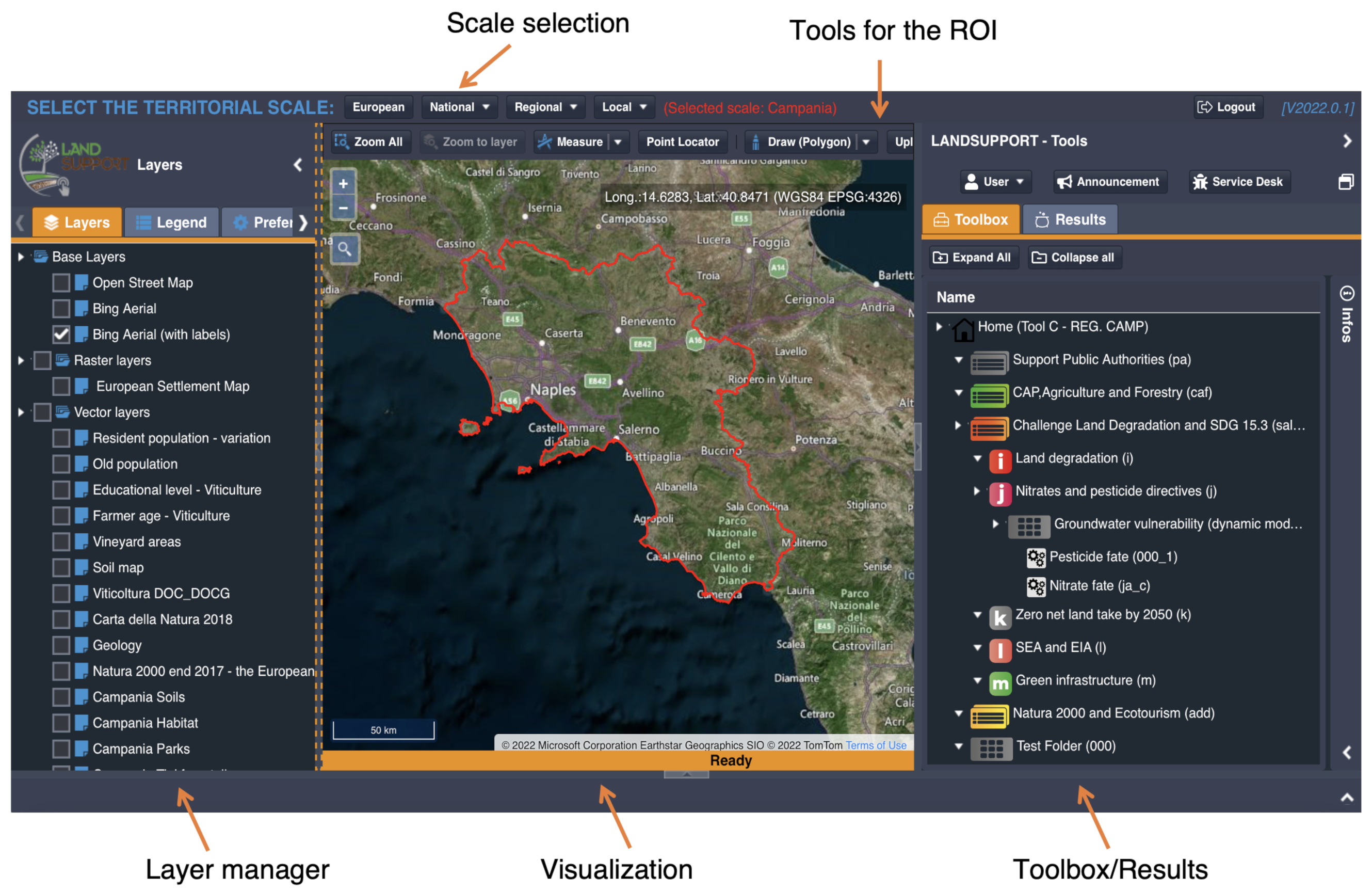

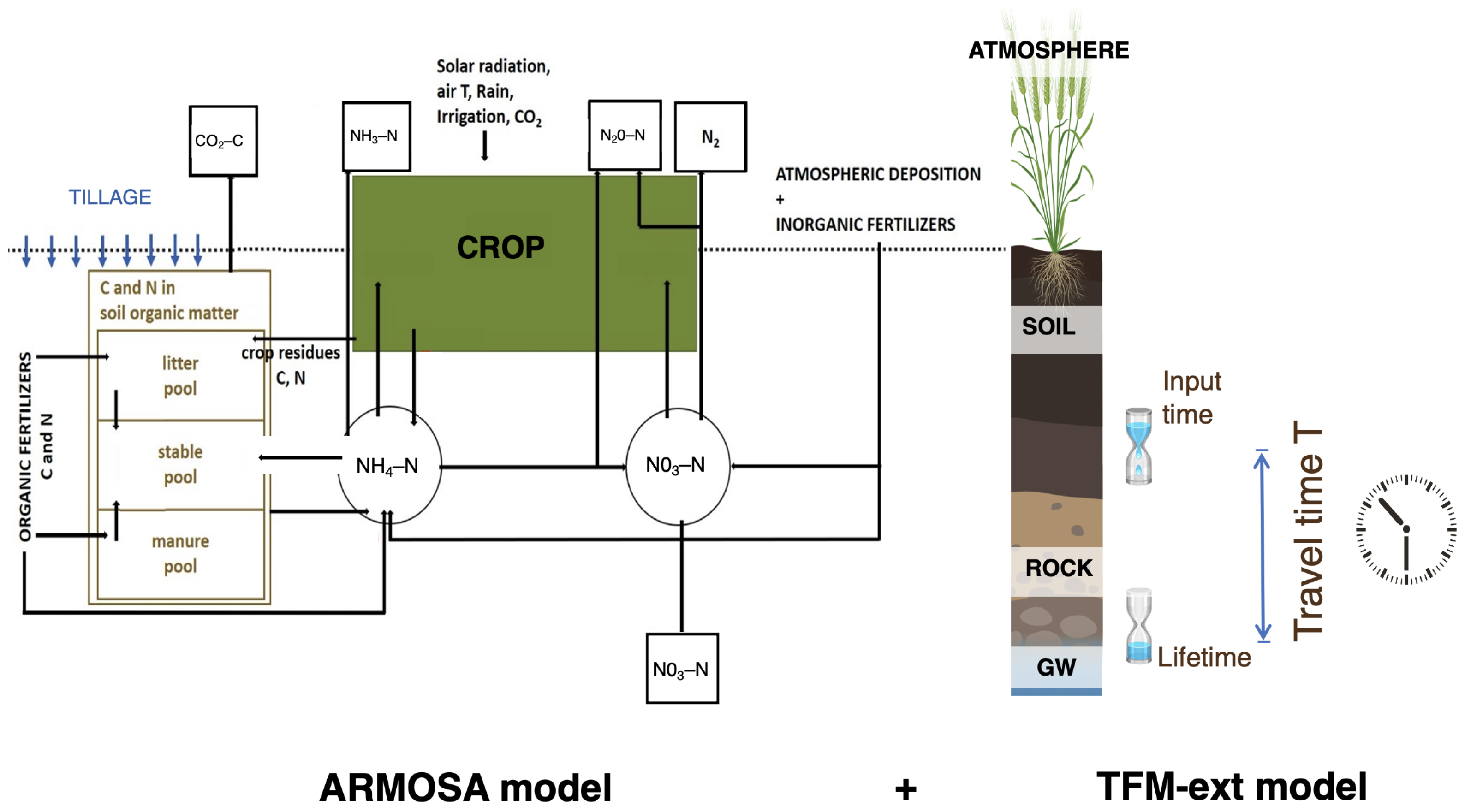

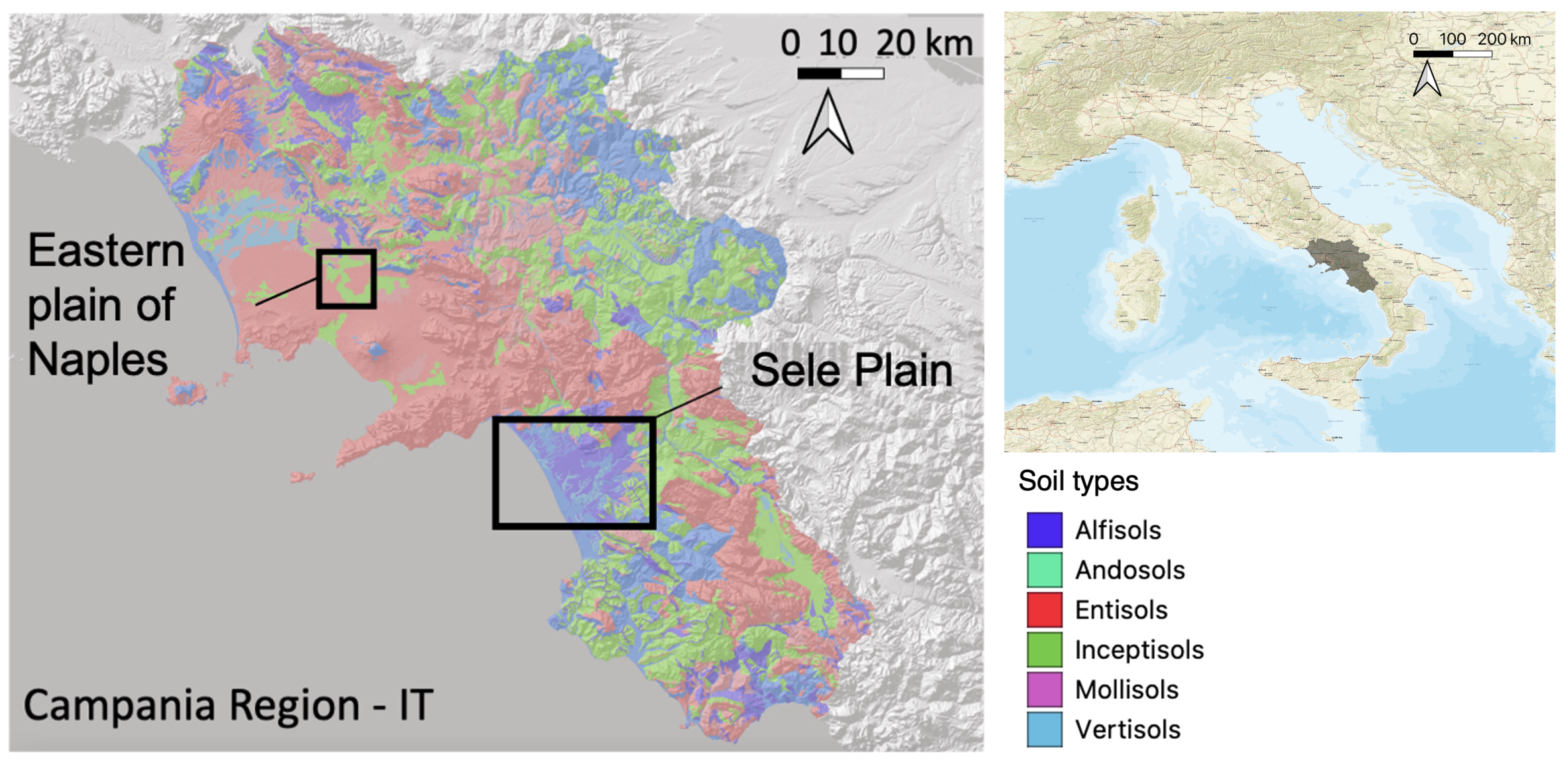
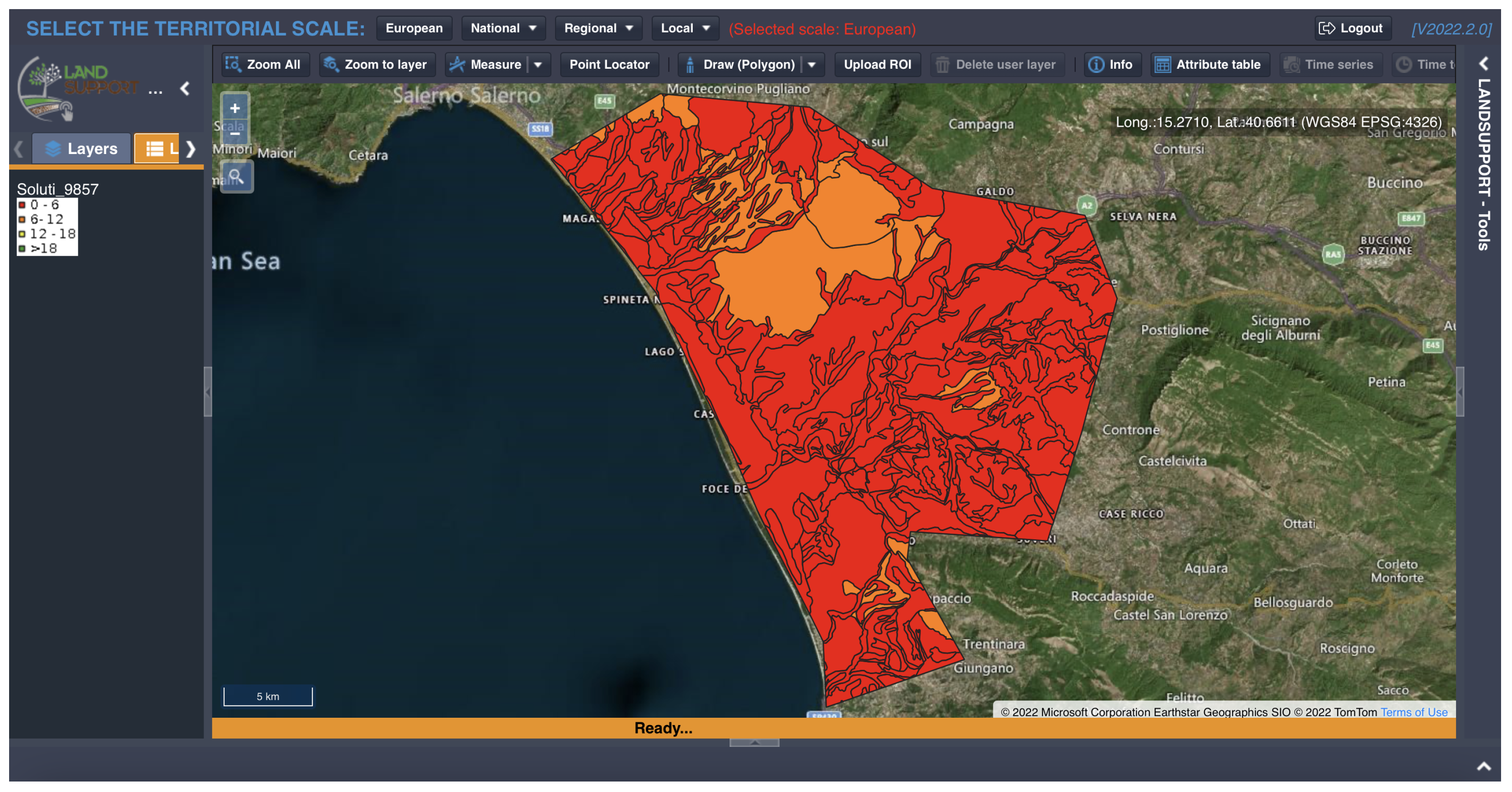
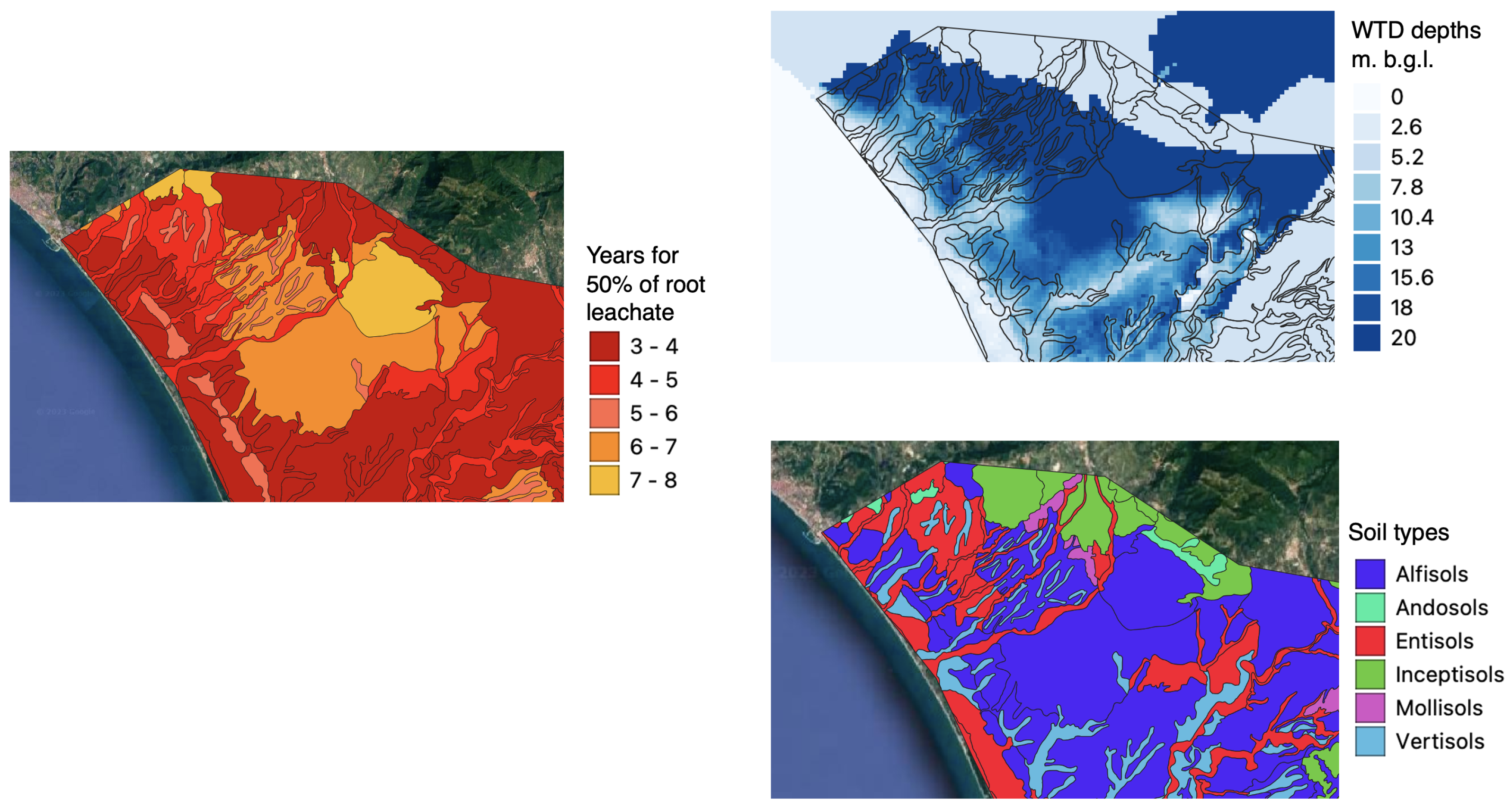
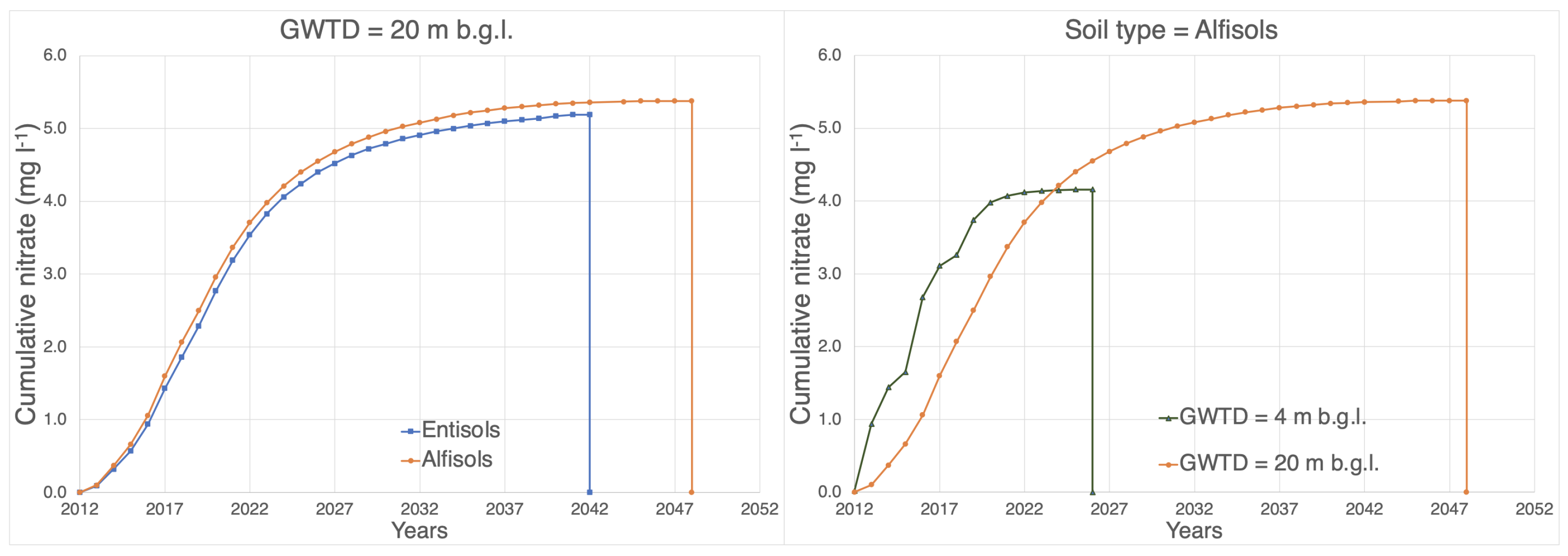


| Name | Case Studies | Type | Applied Methods | Availability |
|---|---|---|---|---|
| LS-NFt (v 1.0) | Campania (IT), Marchfeld (AT) and Zala (HU) | dynamical, real-time | crop-growth and nitrate transfer model | web-based, free and open-source |
| MoNit (v 1.0) | Upper Rhine Valley | static scenarios | crop-growth, nitrate transfer, GW flow and socio-economic models | - |
| NGAUGE (v 1.0) | UK | static scenarios | empirically-based model of N cycling | desktop software |
| DEMETRA (v 1.0) | Dresaim basin (DE) | dynamical | monitoring physico-chemical and biomolecular properties | WEB-GIS, inter-operational geo-database |
Disclaimer/Publisher’s Note: The statements, opinions and data contained in all publications are solely those of the individual author(s) and contributor(s) and not of MDPI and/or the editor(s). MDPI and/or the editor(s) disclaim responsibility for any injury to people or property resulting from any ideas, methods, instructions or products referred to in the content. |
© 2023 by the authors. Licensee MDPI, Basel, Switzerland. This article is an open access article distributed under the terms and conditions of the Creative Commons Attribution (CC BY) license (https://creativecommons.org/licenses/by/4.0/).
Share and Cite
Bancheri, M.; Basile, A.; Botta, M.; Langella, G.; Cavaliere, F.; Bonfante, A.; Ferraro, G.; Acutis, M.; Perego, A. The Nitrate Fate Tool: A Decision Support System for the Assessment of the Groundwater Vulnerability to Nitrate in Support of Sustainable Development Goals. Sustainability 2023, 15, 14164. https://doi.org/10.3390/su151914164
Bancheri M, Basile A, Botta M, Langella G, Cavaliere F, Bonfante A, Ferraro G, Acutis M, Perego A. The Nitrate Fate Tool: A Decision Support System for the Assessment of the Groundwater Vulnerability to Nitrate in Support of Sustainable Development Goals. Sustainability. 2023; 15(19):14164. https://doi.org/10.3390/su151914164
Chicago/Turabian StyleBancheri, Marialaura, Angelo Basile, Marco Botta, Giuliano Langella, Federica Cavaliere, Antonello Bonfante, Giuliano Ferraro, Marco Acutis, and Alessia Perego. 2023. "The Nitrate Fate Tool: A Decision Support System for the Assessment of the Groundwater Vulnerability to Nitrate in Support of Sustainable Development Goals" Sustainability 15, no. 19: 14164. https://doi.org/10.3390/su151914164
APA StyleBancheri, M., Basile, A., Botta, M., Langella, G., Cavaliere, F., Bonfante, A., Ferraro, G., Acutis, M., & Perego, A. (2023). The Nitrate Fate Tool: A Decision Support System for the Assessment of the Groundwater Vulnerability to Nitrate in Support of Sustainable Development Goals. Sustainability, 15(19), 14164. https://doi.org/10.3390/su151914164











